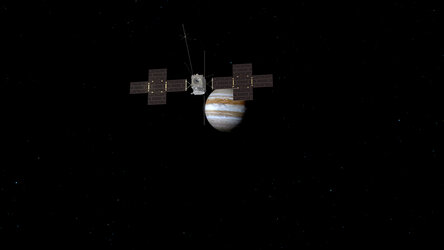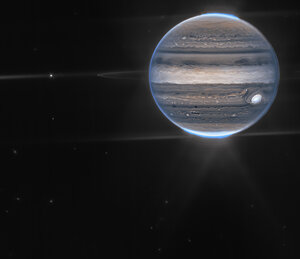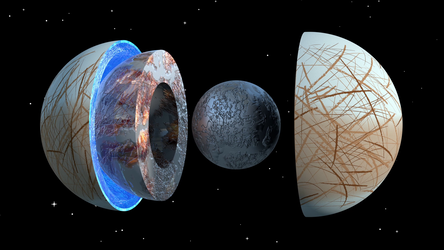Juice and Europa Clipper: Dream team to Jupiter
What’s better than one spacecraft on the quest to search for life-friendly ocean worlds in the Jupiter system? Two! ESA’s Jupiter Icy Moons Explorer (Juice) is set to join forces with NASA’s Europa Clipper – launched on 14 October – to tackle one of the biggest questions in Solar System science.
Are there ingredients for life in the Jupiter system?
Whether life has ever evolved beyond the cradle of Earth is a question that fascinates humankind, and one we have placed in the mechanical hearts of two missions destined for Jupiter’s largest and potentially ocean-bearing moons. Do Europa, Ganymede and Callisto have the ingredients necessary for life?
The Jupiter Icy Moons Explorer, or Juice for short, will look at Jupiter and its largest moons as a complete system, to understand how potentially life-friendly worlds could form around gas giants. The mission has a special emphasis on Ganymede, even spending part of its journey orbiting around the moon. This will make it the first spacecraft to ever orbit a moon in the outer Solar System.
There is also strong evidence for planet-sized Ganymede harbouring an ocean containing more water than all of Earth’s oceans. There is clearly more than meets the eye below Ganymede – and perhaps also Callisto’s – seemingly lifeless cratered surface.
Thanks to earlier missions, scientists also strongly suspect that Europa has an ocean below its thin icy shell. Europa Clipper will dedicate its mission to around 50 flybys of Europa, scanning almost the whole moon and diving as close as 25 km to its surface for the most detailed look yet. While neither spacecraft are designed to detect life itself, they will be able to determine if the ingredients for life are present.

“Juice and Europa Clipper are independent missions with individual science goals, but there are some happy coincidences in their trajectories that we wish to fully exploit to get the most out of both missions as they study the jovian system in the 2030s,” says Claire Vallat, Juice Science Operations Scientist.
“The ESA and NASA teams regularly meet online. We’re working informally together to maximise the scientific harvest of the two missions,” says Emma Bunce, European co-chair of the Juice-Europa Clipper steering group. "From complementary imaging to monitoring dynamic processes from different viewpoints, we should be able to put a lot of our observations into additional context."
Magnetic footprints
Juice’s mission goes beyond studying oceans, with the quest to also understand the origin of Ganymede’s unique magnetic field. Bigger than planet Mercury, Ganymede is the only moon in the Solar System to generate its own intrinsic magnetic field, creating a little magnetic bubble inside Jupiter’s much larger magnetic field.

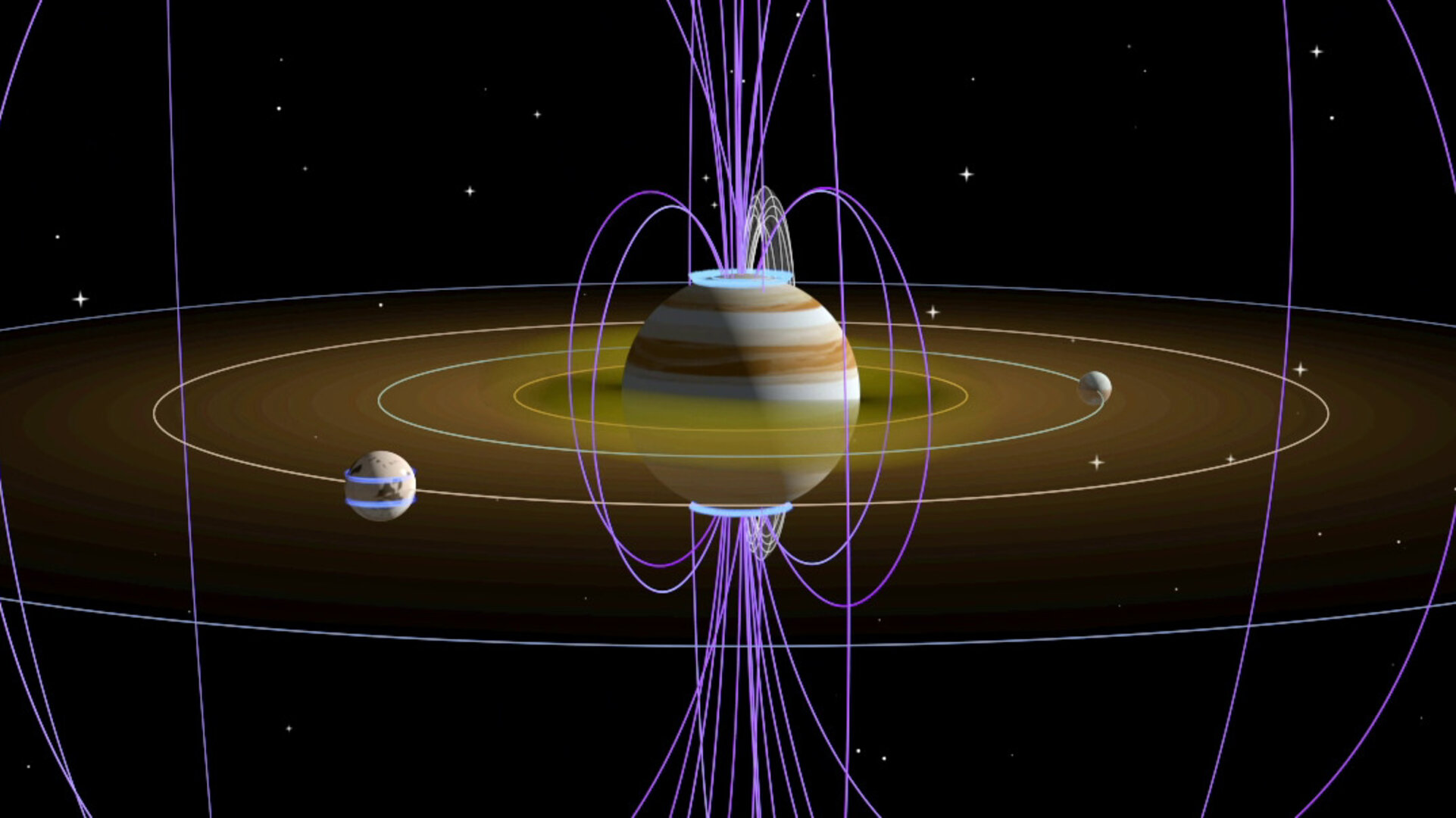
Access the video
Ganymede and Jupiter’s magnetic fields are constantly interacting with the electromagnetic fields and particles flooding the region. These come from the Sun, interstellar space, and Jupiter’s volcanic moon Io, which blasts out high-energy particles that travel throughout the Jupiter system.
One side effect of these interactions is the appearance of auroras. With Juice and Europa Clipper both in the region, it might be possible that one spacecraft, for example, could detect charged particles while the other observes the resulting auroras. This would help to better trace the transport of this material through the Jupiter system.
Jupiter has auroras around its north and south poles, similar to Earth, while Ganymede has a pair of auroral belts, bands of glowing hot gas that encircle the moon at mid-latitudes. The location of these belts provides a probe of the moon's interior, where its magnetic field is generated.
In fact, Ganymede’s auroras are a key piece of evidence for the moon having a subsurface ocean. As the moon’s magnetic field is rocked back and forth by Jupiter’s immense field, ions in the water respond by generating their own ‘induced’ magnetic field, which in turn affects the auroras.
“The observations Juice will make while in orbit around Ganymede will give us in-depth knowledge of how this planet-like moon interacts with Jupiter and its intense magnetic and radiation environment. This is essential if we’re to understand how moons form and evolve as part of a large planetary system, and what constitutes an environment most conducive to life,” adds Olivier Witasse, ESA’s Juice Project Scientist.

Time and tides
A stable location in space is also critical to habitability over time, and as such, the two missions will pay attention to the gravitational interplay between the large moons and Jupiter. Europa Clipper will concentrate on Europa, while Juice will primarily focus on Ganymede while also providing data on the other large moons.
Io, Europa and Ganymede are locked into an orbital dance such that for every orbit Ganymede makes around Jupiter, Europa makes two and Io four. The result of this ‘resonance’ is that they are repeatedly tugged and squashed by immense tidal forces from Jupiter and from each other, which provides energy to heat their interiors, and even keep layers of it liquid.
Innermost Io is so hot it is volcanically active, far too hot to host a liquid water ocean. Outermost Callisto is not in the resonance ‘dance’, although may well have been in the past and is important for understanding the evolution of activity across the four moons.
Spacecraft can be used to determine the positions of the planetary bodies they fly around simply by tracking the radio waves sent between them and Earth.
In the first instance this improves knowledge of where exactly the spacecraft are in relation to the moons they are flying by, which in turn leads to a more precise definition of the moons’ respective orbits around Jupiter. In turn again this helps to plot the orbital dynamics of the moons over time, and how this might have evolved. In addition, when the spacecraft is tugged closer to a moon by small variations in its gravity field, it gives clues as to the internal structure of the moons.
“With two spacecraft making independent measurements around the jovian moons, we have more data to refine our models,” says Olivier.
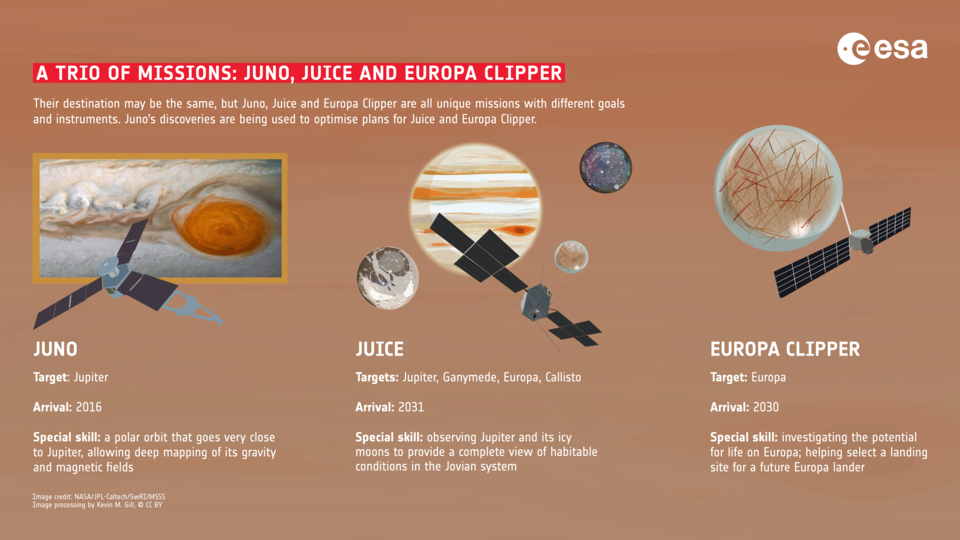
From start to end
Europa Clipper will arrive in the Jupiter system before Juice, and as such might be able to observe Juice’s arrival into Jupiter’s magnetic environment, affording unique joint observations across this turbulent zone. At the same time, Juice could potentially monitor solar wind activity before it reaches Jupiter’s vicinity.
And while Europa Clipper’s orbit is equatorial, Juice will spend time orbiting at higher inclinations, together providing outstanding combined opportunities for tracking changes in time and space from two different locations.
Moreover, according to the current mission plans, both spacecraft are destined to end their missions with a controlled impact onto Ganymede, meaning that there is the possibility that – depending on the missions’ end dates – one spacecraft might have the chance to observe the effects of the other’s impact.
“ESA’s Juice and NASA’s Europa Clipper in the Jupiter system at the same time equals more than the sum of the two parts. It is a really unique opportunity for boosting the science output of both missions while building on the legacy of the discoveries by other missions that have paved the way,” concludes Olivier.
“We will understand with more clarity than ever what ocean worlds beyond Earth are like, and the significance of their interactions with their surrounding environment on habitability potential. This is more important than ever as we seek to understand the habitability potential of planets around other stars.”














 Germany
Germany
 Austria
Austria
 Belgium
Belgium
 Denmark
Denmark
 Spain
Spain
 Estonia
Estonia
 Finland
Finland
 France
France
 Greece
Greece
 Hungary
Hungary
 Ireland
Ireland
 Italy
Italy
 Luxembourg
Luxembourg
 Norway
Norway
 The Netherlands
The Netherlands
 Poland
Poland
 Portugal
Portugal
 Czechia
Czechia
 Romania
Romania
 United Kingdom
United Kingdom
 Slovenia
Slovenia
 Sweden
Sweden
 Switzerland
Switzerland



























